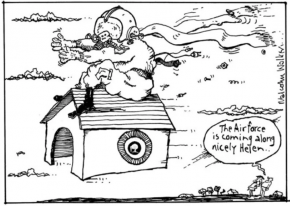In brownout conditions, temporary spatial disorientation is always a concern for troops, as they ingress and egress from helicopters on uneven ground — it’s not a big deal, as tactics will evolve based on technical limitations of each platform type and it is a problem to be managed on all helicopters. And there are various technical solutions being developed for various platforms to de-risk for a brownout.
As you can see, the side pod in the UH-1Y Venom above blocks easy access.
As you can see, the side pod in the UH-1Y Venom above blocks easy access.
Thank you for teaching.In the Bundeswehr a NH90 will if possible always approach and land such that it can be loaded, unloaded and serviced from the right side (pilot's perspective) through ramp and sidedoor. The fuel filler neck as well as the winch is also on the right side btw. In combat configurations the bottom third of the left side door is blocked by a ballistic armour plate (*), and if certain equipment (e.g. stretchers) is installed they similarly block the left side.
Agreed. Your kind input to bring balance to the discussion is greatly valued.I guess it’s theoretically possible to lead pax on a level tarmac or level pitch to enter/exit via a determined path during choreographed training activity, or under very supervised conditions.
but this is fraught with hazard to the pax themselves and the aircraft.
Uneven ground to aft will eat up any height advantage of a higher tail boom/rotor design. If that’s in a hot zone with already disorientated pax it’s a recipe for disaster to exit anywhere aft. Anything projecting higher (antennae, gun barrels, arms) will reduce safety margins to zero.
Uneven ground is even a hazard with the main rotor arc, and any movt under it, even to the 10-2.
An agency advocating a practice of normalising movt under the tail boom during any turning & burning is institutionally sanctioning a ‘trip hazard’, which just might bite them one day. I suggest the helicopter community would instinctively recoil at the practice.
In other words, based on Wombat000’s, Raven22’s and kato’s inputs, the NH90 is not well suited for air assault in a hot LZ, when compared to the Blackhawk — it is also clear that the base design is not well suited to establish an easy all round defence at ingress and egress — a common tactic used to defend the helicopters. Therefore, you are kind of beating a dead horse on the tail boom height discussion. Cheers.That's stating the obvious, on the other hand sometimes the tail may well be higher off the ground giving even more clearance. You use the best option to exit given the circumstances at hand.
Last edited:

